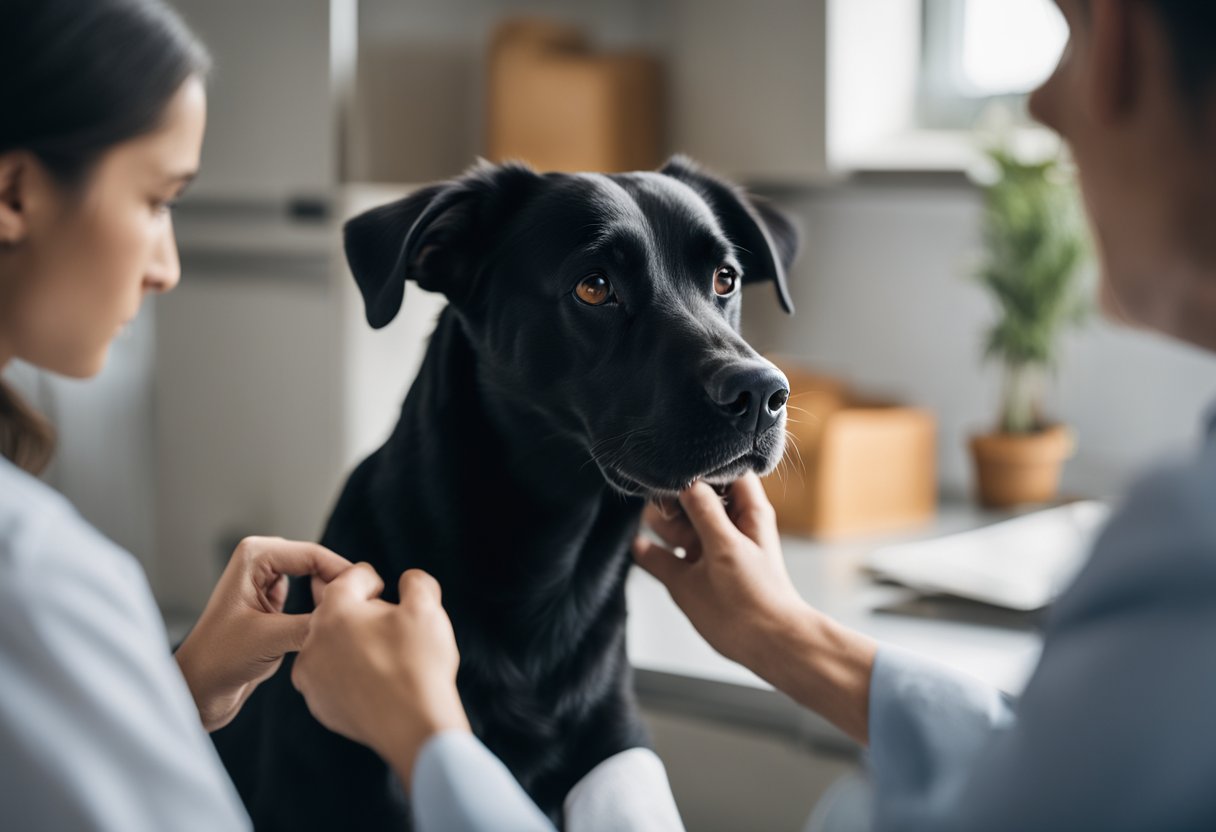Understanding Your Dog’s Vaginal Health
When assessing the vaginal health of your dog, it’s important to distinguish between normal pigmentation and signs of a potential health issue. This involves understanding the anatomy, the role of hormones, and recognizing what normal versus abnormal discoloration looks like.

Anatomy and Normal Pigmentation of the Dog’s Vagina and Vulva
The vulva is the external part of a female dog’s reproductive system and includes the opening to the vagina. It’s not uncommon for the skin in this area to be darker than the surrounding skin, with hues ranging from pink to black, contributing to the overall coloration of the vulva and vagina. This pigmentation can vary depending on the breed and individual characteristics. Normal color changes might occur, but persistent darkening or changes in appearance may require attention.
The Importance of Hormones and the Estrus Cycle
A female dog’s hormonal changes, particularly during the estrus cycle, can influence the appearance of the vulva. During estrus, the vulva becomes swollen and may appear darker due to increased blood flow. This cycle is a natural process and understanding it helps in differentiating between typical hormonal alterations and symptoms that may warrant a vet visit.
Recognizing Normal vs. Abnormal Discoloration
It’s vital for dog owners to differentiate between normal coloration and signs of a medical issue. Healthy vulva and vaginal tissues can vary in color, but owners should be watchful for any abrupt changes in color, especially to a dark or black shade not observed before, which could be indicative of a health concern. Some changes might be linked to natural hormonal fluxes, but if there’s an accompaniment of symptoms like a persistent unusual discharge or odor, a professional evaluation would be prudent. Consulting reputable resources like Common lesions in the female reproductive tract of dogs and cats can provide additional insights into what constitutes abnormal discoloration and potential underlying conditions.
Common Causes for Discoloration and Blackening
When a dog’s vaginal area becomes discolored, turning black, it’s often a sign of an underlying health issue. It’s essential to understand the possible causes, as timely diagnosis and treatment can prevent further complications.

Vaginitis in Dogs and Its Symptoms
Vaginitis in dogs is an inflammation of the vagina that can lead to discoloration. Symptoms commonly include redness, swelling, discharge, and an unpleasant odor. Licking or scooting may be observed if the area is causing discomfort.
The Role of Infections and Common Bacterial Culprits
Infections caused by bacteria can lead to significant changes in a dog’s vaginal health. Common bacteria, such as E. coli and Staphylococcus, are often involved, resulting in discharge and inflammation that can darken the skin.
Yeast Infection and Its Effect on Color and Odor
A yeast infection, caused by the fungus Candida, can also affect the vaginal area, leading to discoloration. This type of infection typically produces a notable odor and a darkening of the skin, which may be accompanied by a discharge.
Identifying and Understanding Related Symptoms

When a dog’s vaginal area appears black, it is crucial to observe any accompanying symptoms to determine the root cause. These symptoms may point to a variety of health issues, ranging from minor irritations to more serious conditions.
Discharge Types: Understanding Color and Consistency
Discharge from a dog’s vagina can vary in color and consistency, providing clues to her health status. A clear or white discharge may be normal, but the presence of yellow, green, or bloody discharge should raise concern. Consistency also matters, with thick or clumpy textures indicating potential infection.
- White: Often normal, unless excessive
- Yellow/Green: Usually signifies infection
- Bloody: May signal injury or serious health issues
Signs of Irritation: Frequent Licking and Rubbing
Dogs often respond to vaginal irritation with behavioral signs. Excessive licking or rubbing against surfaces can indicate discomfort. Redness and swelling are physical signs that accompany irritation. If these symptoms are observed, they should not be ignored, as they can lead to secondary infections or indicate underlying conditions.
- Licking: Can lead to further irritation if excessive
- Rubbing: A sign of discomfort or irritation
Systemic Signs: Behavioural Changes and Discomfort
Changes in a dog’s usual behavior can point to discomfort or pain. A previously active dog becoming lethargic or a friendly dog showing signs of aggression could be responding to pain. Trouble with urination, such as straining or more frequent need to urinate, is also a tell-tale sign that something is amiss.
- Behavioral Changes: Agitation, withdrawal, or aggression
- Urination Difficulties: Straining, increased frequency, or signs of pain
Determining When to Seek Veterinary Care

When unusual symptoms such as a blackened coloration of a dog’s vaginal area are observed, it’s crucial to evaluate the severity, consider potential diagnoses and treatments, and implement proper hygiene practices.
Assessing the Severity of Symptoms
Dogs exhibiting changes in the appearance of their vaginal area, such as blackening, require close observation. Owners should note any additional symptoms like swelling, discharge, or an abnormal odor. If these symptoms are persistent or worsening, they warrant prompt veterinary attention to prevent potential complications.
Possible Diagnosis and Treatments
Blackening of the vaginal area might indicate a condition known as vaginitis, which can be diagnosed through a vaginal cytologic examination. Other concerns could involve pyometra or hormone-related issues, which would require different treatment approaches. For accurate diagnosis and treatment, a veterinarian might perform blood tests or a physical examination. Treatment may range from antibiotics to surgical intervention, depending on the underlying cause.
Preventative Measures and Good Hygiene Practices
To prevent the recurrence of vaginal issues, maintaining good hygiene is crucial. Regular cleaning of the dog’s vaginal area helps reduce the risk of infections. Scheduling routine check-ups with a veterinarian ensures early detection and prevention of potential issues. Owners should be informed about appropriate preventive measures to keep their dogs in optimal health.
Specific Conditions and Diseases Related to Discoloration

Discoloration in a dog’s vaginal area may be indicative of certain health conditions ranging from infections to hormonal changes. It is important to understand the underlying causes to address any potential health issues.
Urinary Tract Infections (UTIs) and Their Effects on Dogs
Urinary Tract Infections are common in dogs and can lead to discoloration of the vaginal area. Signs of a UTI include changes in urination patterns, such as difficulty urinating, frequent attempts to urinate, and bloody or dark urine. Prompt attention and treatment are crucial in preventing complications.
The Impact of Tumors and Anatomic Abnormalities
Tumors or anatomic abnormalities in the reproductive system may also cause discoloration. Masses in the vaginal or penile area can lead to visible changes, including a darker hue of the skin. Consulting a veterinarian for an accurate diagnosis is essential, as treatment will vary depending on the specific condition.
Hormonal Changes and Their Effects on the Female Dog’s Reproductive System
Hormonal fluctuations can alter the appearance of a dog’s vaginal area, especially during certain life stages like puberty or after being spayed. Female dogs may experience changes in pigmentation around the reproductive system due to hormonal imbalances or diseases affecting the uterus. Monitoring and addressing these changes is crucial for the overall health of the dog.
Treatment Options and Management Strategies
When a dog’s vaginal area appears black, it’s important to consider underlying causes such as infection or hormonal issues. The treatment and management of such symptoms require a combination of medical interventions, changes in care practices, and ongoing monitoring.
Medication and Surgical Interventions
The treatment of a discolored vaginal area in dogs often involves medications if the discoloration is due to an infection like vaginitis or a yeast infection. Antibiotics may be prescribed to combat bacterial infections, whereas antifungal medications are used for yeast infections. If the discoloration is associated with a more serious underlying condition, such as a tumor or severe structural anomaly, surgery may be necessary. In cases like urinary incontinence, a percutaneously adjustable hydraulic urethral sphincter has been used in dogs to manage this condition.
Lifestyle and Dietary Recommendations
Management of the dog’s vaginal health includes lifestyle and dietary recommendations to prevent recurrence of symptoms. Owners are advised to ensure regular grooming to keep the vaginal area clean and dry, as moisture can promote the growth of yeast and bacteria. Additionally, a balanced diet that supports a healthy immune system can be beneficial. Dietary changes should be discussed with a veterinarian to determine if they can help manage the dog’s condition and overall health.
Follow-up Care and Monitoring
Follow-up care is critical in managing a dog’s vaginal health. Regular veterinary check-ups will help monitor the effectiveness of the treatment and manage any ongoing or recurrent issues. Veterinarians may perform repeated vaginal cytology or urinalysis to ensure infections are resolved. Continual monitoring of the dog’s symptoms by the owner, including noting any changes in the color of the vaginal area or the presence of discharge, is essential for ongoing management.
Frequently Asked Questions
In addressing the concerns about color changes in a dog’s genital area, it’s important to understand the possible reasons, from the benign like natural pigmentation to indications of health issues such as infections.
What causes hyperpigmentation in dogs?
Hyperpigmentation in dogs can be caused by several factors including genetics, inflammation, hormonal imbalances, or skin conditions. It usually appears as darkened patches of skin, which could also affect the genital area.
How can I tell if my dog has a genital infection?
Signs of a genital infection in a dog include redness, swelling, tenderness, persistent licking of the area, unusual discharge, and a foul odor. If these symptoms are present, it’s advisable to consult a veterinarian.
Is it normal for a female dog’s private area to change color?
A change in color of the female dog’s private area can occur due to hormonal changes, especially during estrus. However, significant or sudden changes in color should be evaluated by a veterinarian to rule out any underlying issues.
What are the signs of infection in a dog’s reproductive system?
Signs of infection in a dog’s reproductive system may include vaginal discharge that is yellow, green, or black, lethargy, decreased appetite, fever, and if the infection is severe, signs of shock or collapse.
Can a dog’s diet affect the color of their genital area?
A dog’s diet is typically not directly related to the pigmentation of their genital area. If the dog’s skin is reacting to a certain food substance, it could indicate an allergy or sensitivity rather than a dietary effect on skin color.
What does black discharge indicate in female dogs?
Black discharge in female dogs could be a sign of a serious health issue, such as a uterine infection like pyometra or leftover tissue post-whelping. It is important for a veterinarian to examine the dog if black discharge is observed.
